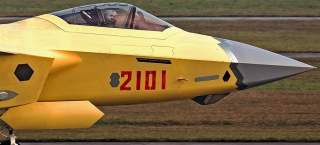Stealth Fighter Showdown: China's New J-20 vs. Russia's Super T-50 PAK-FA
Who would win this battle?
China’s J-20 stealth fighter is making headlines around the world--and for obvious reasons.
While the plane has been seen in various testing phases for some years now, the aircraft just made its official debut at an airshow in China--a symbol of Beijing’s growing military muscle.
Combined with China’s new aircraft carrier (with a second now nearing completion, the first built in a Chinese shipyard, by the way), various types of advanced antiship weapons, multiple versions of advanced submarines and more, Beijing clearly is on a course (many argue already is) to become one of the world’s most dangerous military powers, alongside Russia and America.
But how would China’s new stealth jet do in open warfare? Could it really tangle with the world’s best? Here is a question: What about a matchup against Russia’s new 5th generation fighter, the PAK-FA. Last year, TNI’s Defense Editor, Dave Majumdar, explored this question. So who would win? Let the debate begin…
***
Russia and China have recently moved closer together as they collaborate to limit U.S. influence around the globe. However, relations between the two great powers have not always been so cozy.
Indeed, the People’s Republic of China and the Soviet Union even fought a brief undeclared border war in 1969, shattering the illusion of a monolithic Communist bloc. While China and post-Soviet Russia have recently been drawn together, there is always the possibility that in the future their interests may diverge. In the event of conflict, air power would play a key role.
So how might Russia’s Sukhoi T-50 PAK-FA fare against the Chinese Chengdu J-20? That would depend on the type of conflict. Indeed, as I have noted before, while the PAK-FA is definitely an air superiority fighter, it’s not clear that the J-20 is a fighter at all.
If there was war in Russia’s Far East, where a conflict with China might take place, range will be an important factor. While there is no specific information available about the range performance of either the J-20 or PAK-FA, given the size of the Chinese aircraft, one suspects it has longer legs. It probably also has a much greater payload. Overall, the J-20 could be the more useful machine if it was used as a strike aircraft.
It’s hard to say what would happen if the two aircraft were to meet head on in an aerial battle. There has never been an instance where two stealth aircraft have met in an air-to-air encounter. Until recently, the Lockheed Martin F-22 Raptor was the only operational stealth fighter on the planet. Previous aircraft like the F-117 and the B-2 are obviously optimized for air-to-ground attacks.
If the J-20 and PAK-FA prove to be genuinely stealthy, an aerial engagement might devolve into a within visual range dogfight. That’s assuming the two opposing forces could find each other.
One might imagine that low frequency radar would be able to direct the groups of jets into the right vicinity. The Russian and Chinese jets might then be able to locate each other more precisely using their infrared search and track capabilities. However, discerning accurate range data from an infrared sensor is problematic—and it’s not clear if the either the Russian or Chinese can derive a weapons quality track from those cameras. Thus neither side would necessarily be able shoot from any great range.
That means the two opposing forces would be forced into a visual range fight. The J-20, which is powered by engines intended for the Sukhoi Su-27, is at a huge disadvantage. Compared to the PAK-FA, the J-20 is underpowered and wouldn’t have the energy addition to keep up. Moreover, the PAK-FA has three-dimensional thrust vectoring for outstanding low speed handling. That means the Russian aircraft probably has the edge in turn rate, turn radius and high angle of attack performance. But if both sides have high off-boresight missiles and helmet-mounted cueing systems, with a little luck, the J-20 might get a lucky shot—however, the PAK-FA probably still has the edge.
Ultimately, all this is pure speculation and hopefully will remain that way. A war between Russia and China would not be good for either nation—and could drag in other powers and lead to a wider conflict.

